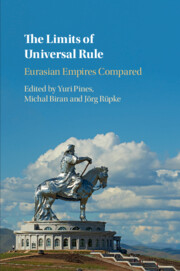Book contents
- The Limits of Universal Rule
- The Limits of Universal Rule
- Copyright page
- Contents
- Maps
- Figures
- Contributors
- Abbreviations
- Preface
- Introduction
- 1 From the Mediterranean to the Indus Valley: Modalities and Limitations of the Achaemenid Imperial Space
- 2 Limits of All-Under-Heaven: Ideology and Praxis of “Great Unity” in Early Chinese Empire
- 3 The Roman Empire
- 4 The Medieval Roman Empire of the East as a Spatial Phenomenon (300–1204 CE)
- 5 Early Islamic Imperial Space
- 6 The Mongol Imperial Space
- 7 The Territories and Boundaries of Empires
- 8 Delimiting the Realm Under the Ming Dynasty
- 9 The Expansion of the Qing Empire Before 1800
- 10 All Under the Tsar
- Index
- References
6 - The Mongol Imperial Space
From Universalism to Glocalization*
Published online by Cambridge University Press: 07 January 2021
- The Limits of Universal Rule
- The Limits of Universal Rule
- Copyright page
- Contents
- Maps
- Figures
- Contributors
- Abbreviations
- Preface
- Introduction
- 1 From the Mediterranean to the Indus Valley: Modalities and Limitations of the Achaemenid Imperial Space
- 2 Limits of All-Under-Heaven: Ideology and Praxis of “Great Unity” in Early Chinese Empire
- 3 The Roman Empire
- 4 The Medieval Roman Empire of the East as a Spatial Phenomenon (300–1204 CE)
- 5 Early Islamic Imperial Space
- 6 The Mongol Imperial Space
- 7 The Territories and Boundaries of Empires
- 8 Delimiting the Realm Under the Ming Dynasty
- 9 The Expansion of the Qing Empire Before 1800
- 10 All Under the Tsar
- Index
- References
Summary
This study seeks to explain how the Mongol imperial space was created and administrated by the Mongols and conceived by the Mongols and their subjects mainly in Yuan China and Ilkhanid Iran. It stresses the interplay between the Mongols’ universal vision, their construction of a “Chinggisid space,” and the revival of “glocal” (i.e., local with global characteristic) spatial concepts in Mongol-ruled China and Iran. It starts by reviewing Mongol expansion, analyzing the reasons for its unprecedented success and the impact of its halt, and concludes in assessing the impact of the Mongol Empire on the shaping of the post-Mongol imperial space across Eurasia.
Keywords
- Type
- Chapter
- Information
- The Limits of Universal RuleEurasian Empires Compared, pp. 220 - 256Publisher: Cambridge University PressPrint publication year: 2021
References
- 3
- Cited by

